Peridot Cut
Those of us born in August know that we have a Peridot birthstone. Its green color is inspiring, evoking the color of summer foliage. But turning raw Peridot into jewelry requires a lot of delicate work. Peridot crystal comes out of the ground in rough shapes that need cutting and polishing to make it ready to become something special. How is this done?
TABLE OF CONTENTS
Peridot Cutting Basics
Like all gemstones, Peridot is cut by someone called a gem cutter or lapidary. This process starts with the selection of a crystal, and a careful evaluation of its potential. Then, it's cut into a preform of the basic final shape, and the lapidary will attach the stone to a stick, called a dop. Slowly, the Peridot is ground down into facets, using a series of diamond grit wheels.
First, the pavilion (or lower part) of the Peridot is cut into facets, then the table. When each side of the gemstone is faceted, it is polished. When finished, a faceted gem can be set into Peridot jewelry. Options include earrings and necklaces, or even a Peridot engagement ring.
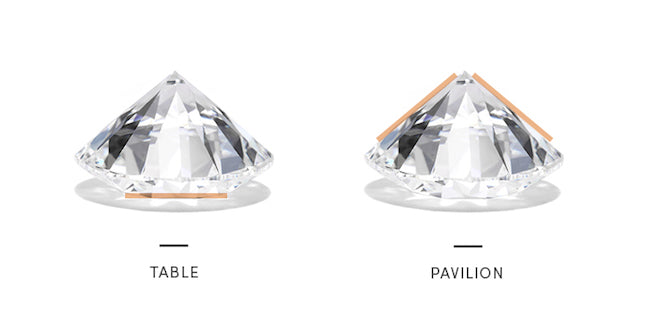
Cut and Shape Options for Peridot
Depending on manufacturer needs or other preferences, the gem cutter has a wide variety of choices when cutting raw Peridot. Here are a few of them.
Step Cuts
Step cuts are the ones that generally feature clean lines, instead of curves. Facets are cut parallel to each other, and the facets are shaped like squares or rectangles. What's important is that all the lines are straight. Step cuts come in several types, depending on the shape.
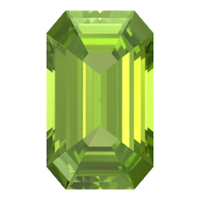
Emerald Cut
Emerald cut Peridots are the most popular step cut option. They can be set in earrings or necklaces, or become an emerald cut Peridot ring. One of the great things about emerald cuts is that they showcase the gorgeous green that makes the gemstone famous. Corners are cut off so that they aren't sharp, leaving a long, clean line.
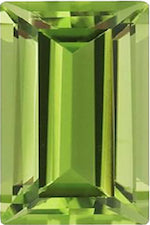
Baguette Cut
These are longer and skinnier than emerald cuts, and somewhat less popular. However, baguette-cut Peridots make excellent accent stones alongside faceted gems of a different shape.
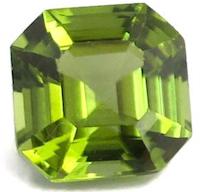
Asscher Cut
If you've ever seen a faceted gemstone that looks like a square emerald, that's an Asscher. These are cut the same way, except that all sides are the same length. As a step-cut, Asscher show off a gem that has high clarity.
Brilliant Cuts
Brilliant cuts are quite different from step cuts. For one thing, they have facets that sometimes appear to form curved lines. Individual facets are triangular or kite-shaped, though recently a hearts and arrows technique has been added to the mix. Here are some examples of brilliant cuts.

Round Cut
Living up to its name, a round brilliant cut is the most popular choice for a Peridot engagement ring. Viewed from above, the round Peridot looks circular. There are a couple different types of round brilliant, including the traditional version and the “hearts and arrows” shape that’s been designed to increase fire even more.
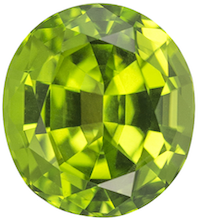
Oval Cut
This one is the elongated version of a round brilliant: two sides are longer, while two are shorter. Oval shaped gems are popular for Peridot gold ring, because they make fingers look more slender.
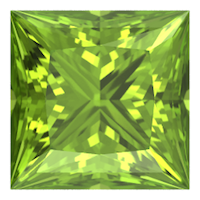
Other Options
Peridot princess cut engagement rings are popular, because this square-shaped brilliant cut is an economical choice with lots of brilliance. Marquise cut Peridots have two points connected by two rounded sides. Pear and heart shapes have one point, with a rounded end or cut-out ends for the heart.
Other Peridot Cuts: Mixed, Fantasy, Cabochon
Faceted gemstones that do not fit purely within the step cut or brilliant-cut category are said to have a mixed or fantasy cut.

Mixed cuts usually are more normal-looking, but the lapidary wanted to bring out something special in the gem.
Fantasy cuts are mostly custom gemstones that show off the cutter's skill. Lastly, Peridot can be made into beads and cabochons.
Cabochons are domed stones that have been polished to a brilliant shine. Hobbyists also enjoy beads. These can be faceted or cut smoothed out, and all types have a hole for stringing or jewelry pegs.
Choosing Peridot Cut
While consumer demand and manufacturer specifications are always a consideration when cutting rough gemstones, the lapidary will always consider the clarity of the gem. In particular, this means the presence or lack of inclusions, which are anything inside the gem that can obstruct you from looking straight through the stone.
Peridot Inclusions
According to the GIA, the most common inclusions for this lime green gem are black dots and lily pads. These black dots are tiny crystals that were absorbed by the crystal as it grew. Whereas lily pads are circular cracks in the stone. Other inclusion possibilities include needles (thin crystals), feathers (narrow cracks), and internal graining (unevenness within the crystal). When these inclusions are large enough, they'll reduce the value of the stone.
Generally, if a Peridot has tiny inclusions that can't be seen, or if it can be cut to fit those specifications, a lapidary is more likely to facet it. On the other hand, Peridot that has a greater number of inclusions is an excellent candidate for cabochons or beads. There are two reasons for this.
- Facets show off the clarity of stones.
- Faceted gems are usually made into the more expensive jewelry.
Peridot Common Inclusions

Black Dots
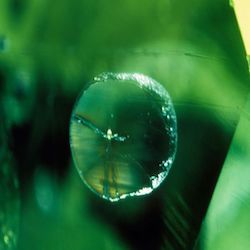
Lily Pads

Feathers
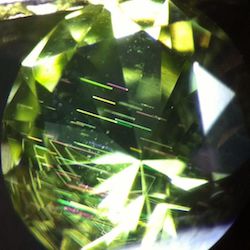
Graining/Needles
Peridot Treatment
Lastly, Peridot might be treated before or after cutting. At With Clarity, we sell high-quality Peridot jewelry. However, some of it might be heat treated to increase the clarity and improve Peridot color. Our Peridot engagement ring offerings include styles with stones up to 3.05 carats and costing between $400 and $2,000. You have a choice between 14kt yellow gold, white gold, or rose gold. Give us a call if you have any questions about choosing a perfect gift.
FAQs
Which is the ideal cut for a peridot?
Is round peridot better than an oval?
Which are the most common inclusions in peridots?







